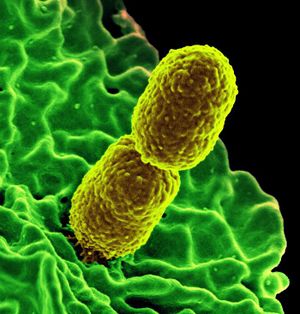Carbapenem-resistant Enterobacteriaceae (CRE)
Section
By [My Name]
At right is a sample image insertion. It works for any image uploaded anywhere to MicrobeWiki.
The insertion code consists of:
Double brackets: [[
Filename: PHIL_1181_lores.jpg
Thumbnail status: |thumb|
Pixel size: |300px|
Placement on page: |right|
Legend/credit: Electron micrograph of the Ebola Zaire virus. This was the first photo ever taken of the virus, on 10/13/1976. By Dr. F.A. Murphy, now at U.C. Davis, then at the CDC.
Closed double brackets: ]]
Other examples:
Bold
Italic
Subscript: H2O
Superscript: Fe3+
Carbapenem-resistant Enterobacteriaceae (CRE) are a family of Gram-negative bacteria that are resistant to carbapenem, a class of anti-biotics used to treat infections. Carbapenems offer a broad-spectrum defense against a wide variety of both Gram-negative and Gram-positive bacteria, meaning that increasing resistance by CRE, to which there is no reliable treatment, is a major concern for the health industry. [2,3] Previously rare in the United States before 1992, CRE are becoming increasingly more common.[1] Although Enterobacteriaceae are normal human intestinal flora, resistance may be caused by the occurrence of hydrolyzing enzymes, such as serine β-lactamase KPC and the metallo–β-lactamase VIM.[3] Resistance to carbapenems is common in a number of Enterobacteriaceae, such as Kelbsiella pneumoniae and E. coli [3]. CRE typically cause infections in patients of hospitals and nursing homes [3]. The increasing prevalence and lack of reliable treatment have led many to predict CRE as the next "superbug." [3]
Introduce the topic of your paper. What is your research question? What experiments have addressed your question? Applications for medicine and/or environment?
Sample citations: [2]
[3]
A citation code consists of a hyperlinked reference within "ref" begin and end codes.
Section 1
Include some current research, with at least one figure showing data.
Every point of information REQUIRES CITATION using the citation tool shown above.
Section 2
Include some current research, with at least one figure showing data.
Section 3
Include some current research, with at least one figure showing data.
Section 4
Conclusion
References
Authored by Carter Powell for BIOL 238 Microbiology, taught by Joan Slonczewski, 2017, Kenyon College.
Edited by Carter Powell for BIOL 238 Microbiology, 2017, Kenyon College.
- ↑ Neil Gupta, Brandi M. Limbago, Jean B. Patel, Alexander J. Kallen; Carbapenem-Resistant Enterobacteriaceae: Epidemiology and Prevention. Clin Infect Dis 2011; 53 (1): 60-67. doi: 10.1093/cid/cir202
- ↑ Hodgkin, J. and Partridge, F.A. "Caenorhabditis elegans meets microsporidia: the nematode killers from Paris." 2008. PLoS Biology 6:2634-2637.
- ↑ Bartlett et al.: Oncolytic viruses as therapeutic cancer vaccines. Molecular Cancer 2013 12:103.

